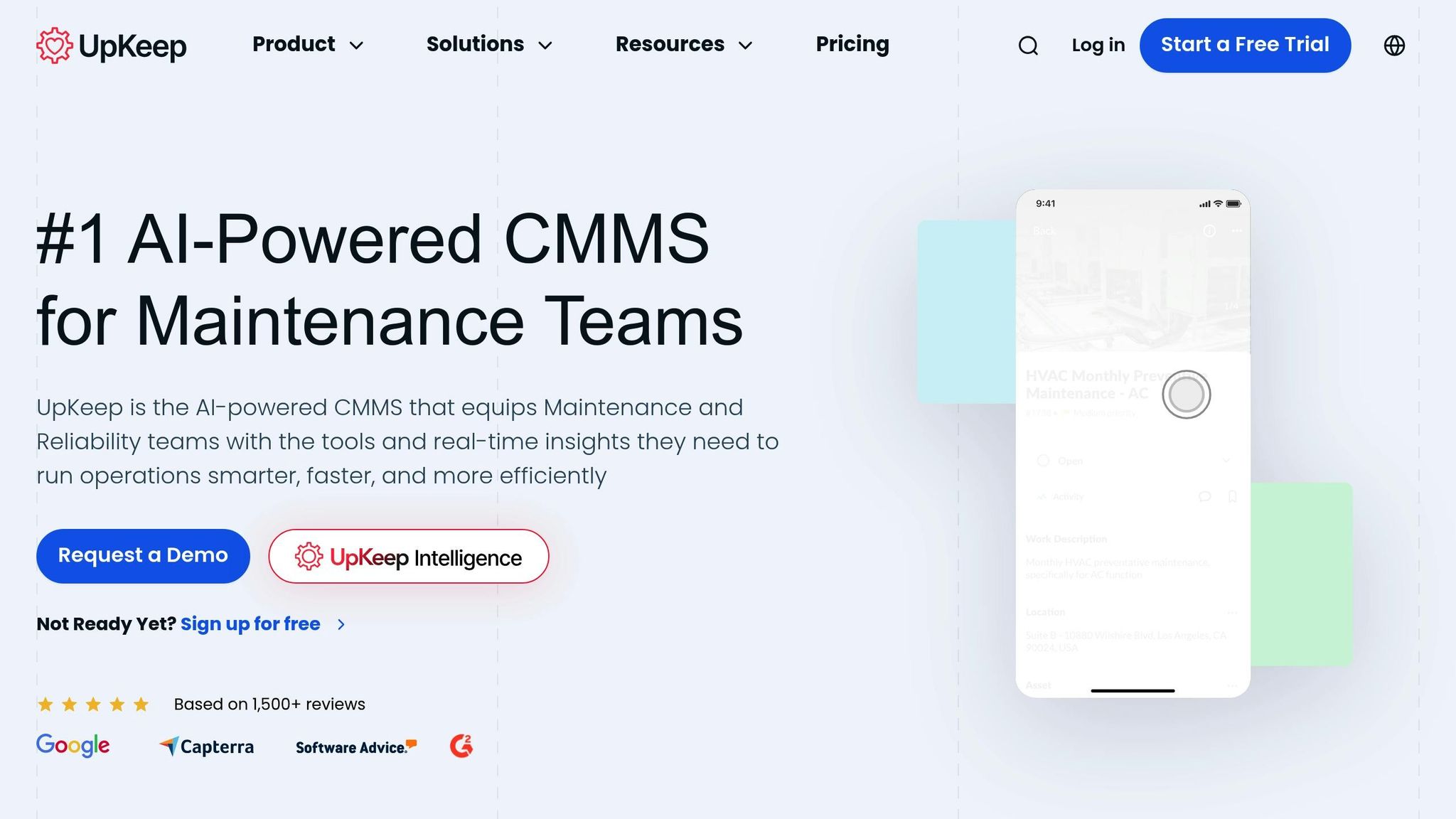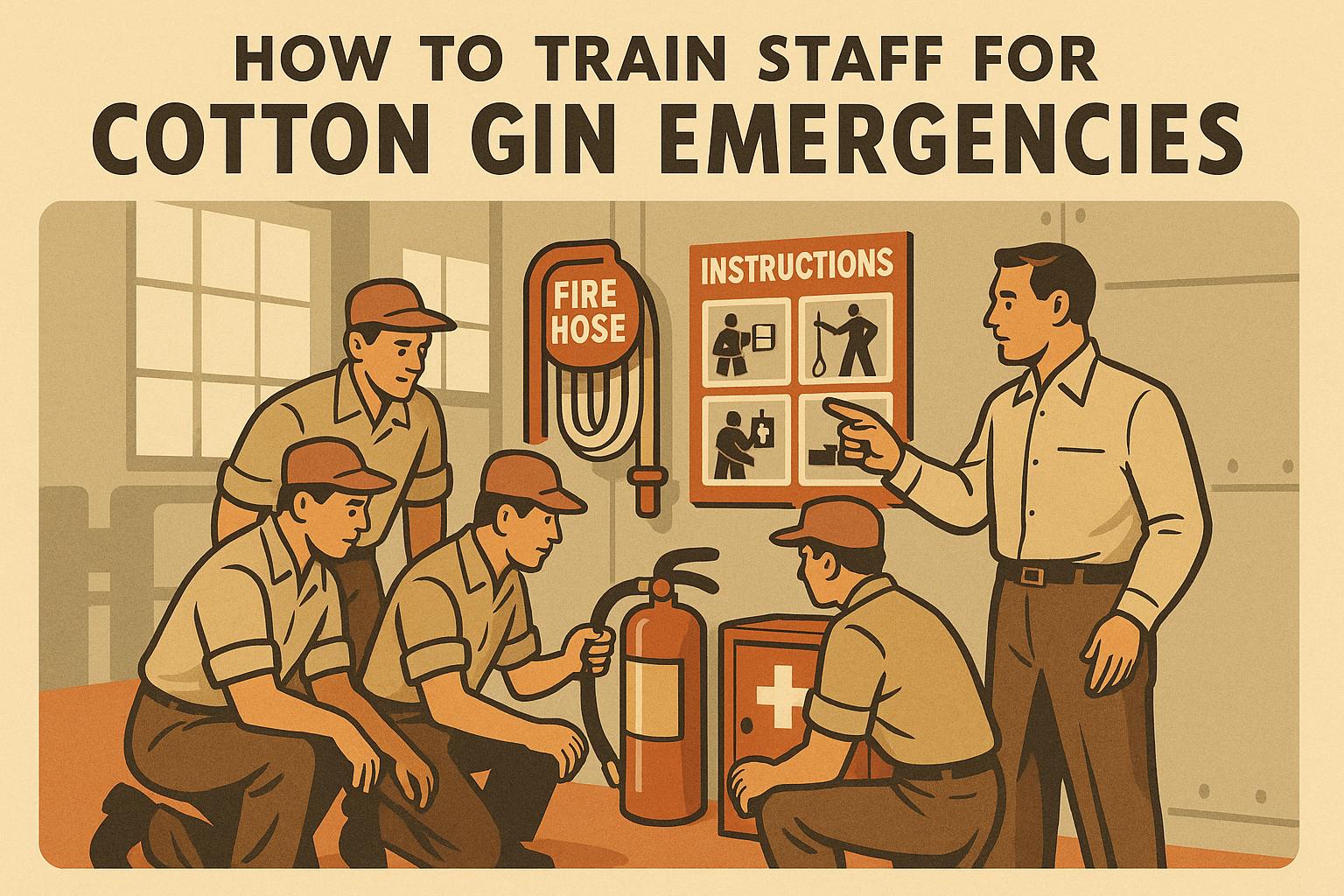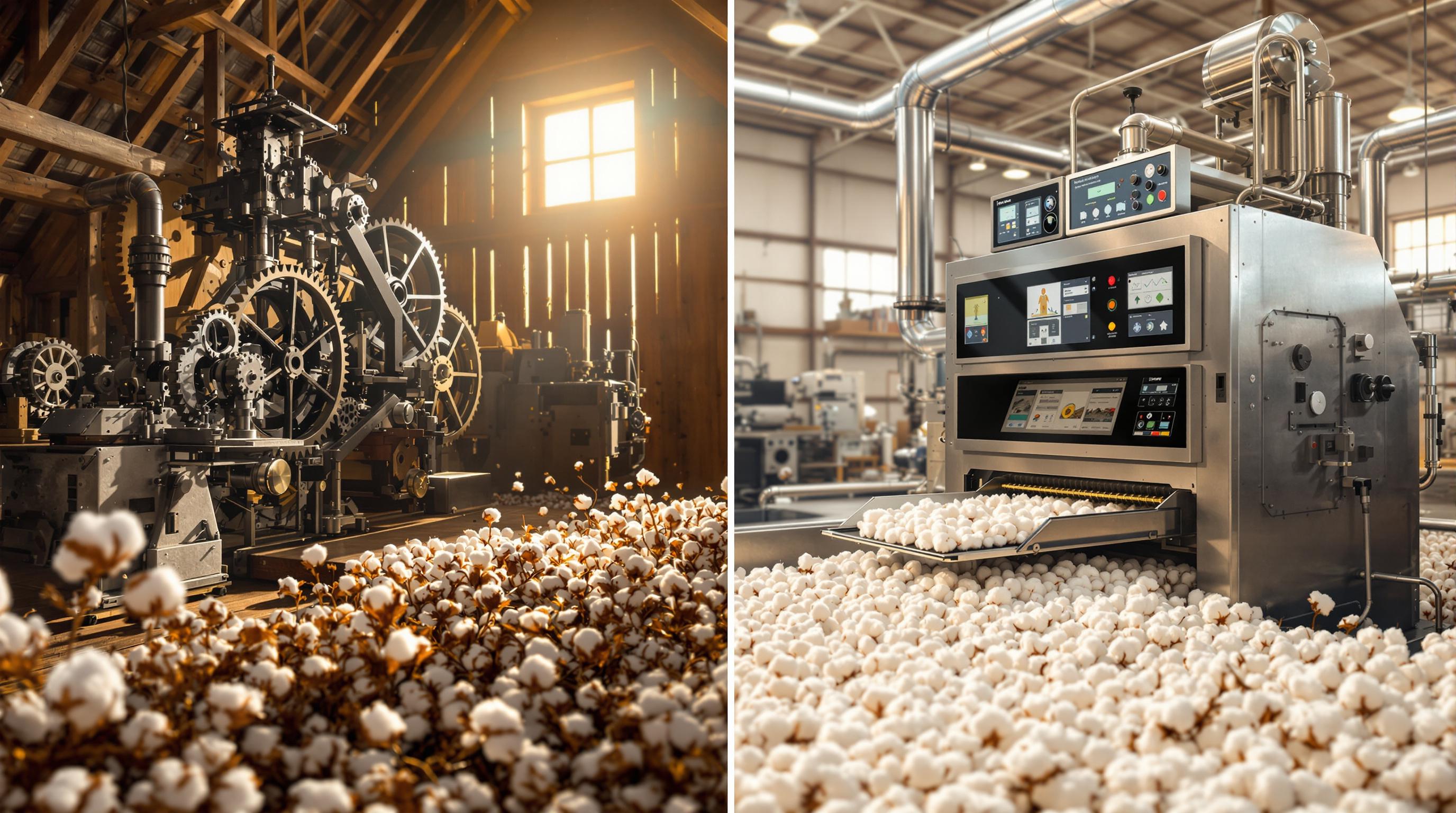Want to save money and avoid downtime? For cotton gin operators, choosing the right maintenance strategy is critical. Here’s the key takeaway:
- Predictive Maintenance: Uses sensors and data to predict when repairs are needed. It reduces downtime by 35-45%, cuts maintenance costs by 25-30%, and extends equipment life by 15-20%. Initial setup costs range from $50,000 to $500,000, but it offers long-term savings and a 10x ROI.
- Reactive Repairs: Fixes equipment only after it breaks. While cheaper upfront, it leads to 2-5x higher long-term costs due to unplanned downtime, emergency repairs, and shorter equipment lifespan.
Quick Comparison
| Factor | Predictive Maintenance | Reactive Repairs |
|---|---|---|
| Upfront Cost | High ($50,000–$500,000) | Low |
| Annual Costs | 25–30% lower | 25–30% higher |
| Downtime | Reduced by 35–45% | High risk of unplanned downtime |
| Equipment Lifespan | Extended by 15–20% | Shortened by up to 30% |
| Emergency Costs | Minimal | 3–4x higher than planned repairs |
| Overall Savings | Up to 40% | 2–5x more expensive long-term |
Bottom Line: Predictive maintenance costs more upfront but saves money and boosts efficiency in the long run. Reactive repairs may seem cheaper but lead to higher costs and risks during critical harvest seasons.
Predictive Maintenance: Features, Benefits, and Costs
Key Features of Predictive Maintenance
Predictive maintenance systems rely on sensors and real-time data to keep a close eye on equipment. These systems constantly track factors like temperature, humidity, vibration, and overall machinery performance to spot potential problems before they turn into costly breakdowns.
By analyzing operational data, these systems can predict when failures might occur and identify which parts need attention. Their ability to handle large amounts of data makes them especially useful for operations that run at high capacity.
The technology integrates smoothly with existing equipment. Sensors can be added to older machines or incorporated into new ones, sending data to centralized systems. Operators can then monitor real-time updates, receive alerts about potential issues, and plan maintenance during less critical times. These features create a foundation for improving both performance and cost management.
Benefits of Predictive Maintenance
Predictive maintenance delivers noticeable operational improvements. For example, uptime can increase by 20%, which is especially valuable during the short ginning season when every minute counts. Research shows that these systems can cut downtime by 35–50%, with some setups reducing unplanned downtime by 30–40%. This boost in uptime and reduction in downtime directly lowers operational costs.
Additionally, equipment can last 20–40% longer, reducing the need for frequent and expensive replacements. By keeping machines running at peak performance, cotton gins can maintain more consistent processing quality. Safety also gets a boost, as early detection of issues reduces the risk of severe breakdowns that could harm workers or damage facilities.
These efficiency gains make predictive maintenance a cost-effective alternative to reactive repair strategies.
Implementation Costs and Requirements
While the upfront investment can be steep, the long-term savings make predictive maintenance a smart choice. Typical implementation costs range from $50,000 to $500,000, covering sensors ($50,000–$200,000), software ($30,000–$150,000), integration ($20,000–$100,000), and training ($10,000–$50,000).
Despite these initial costs, the financial benefits are hard to ignore. According to the U.S. Department of Energy, predictive maintenance saves 8–12% compared to preventive maintenance and up to 40% compared to reactive maintenance. Even more compelling, predictive analytics can deliver a tenfold return on investment, with savings of 30–40%.
The payback period for these systems is typically between 12 and 24 months. For instance, one European manufacturer spent about $715,000 (originally €650,000) on a predictive maintenance system, reduced unplanned downtime by 70%, and recovered the investment within just five months. This resulted in annual savings of approximately $1.65 million (originally €1.5 million).
For cotton gin operators, the long-term benefits grow as more data is collected, making these systems an even more attractive investment over time.
Reactive Repairs: Features, Limitations, and Costs
Key Features of Reactive Repairs
Reactive maintenance is a straightforward approach: equipment is fixed only after it breaks down. This method requires minimal upfront investment, as it doesn’t rely on advanced monitoring systems - just basic repair tools and a small inventory of spare parts. For cotton gin operators, this typically means waiting for equipment to fail, diagnosing the issue, and then repairing it to get operations back on track.
This "run-to-failure" strategy focuses on keeping equipment in use until it stops functioning entirely. When breakdowns occur, the process depends on having technicians, replacement parts, and other resources ready to address the problem quickly. While it may seem simple, this approach brings significant risks to reliability and overall costs.
Limitations of Reactive Repairs
Reactive repairs come with some serious drawbacks, especially when it comes to operational efficiency and profitability. For example, 82% of companies have experienced at least one unplanned downtime event in the past three years, showing how widespread unexpected failures are across industries.
One major issue is unplanned downtime, which can be incredibly costly. During the ginning season, every hour of downtime means lost revenue, as cotton processing grinds to a halt.
Another concern is the shortened lifespan of equipment. Machines that are run until they break often suffer more extensive damage, compared to those receiving regular maintenance. This leads to more frequent and expensive repairs over time.
Safety risks also come into play. Sudden equipment failures can create hazardous situations, especially when dealing with heavy machinery like cotton gin presses. The unpredictability of breakdowns makes it harder to maintain a consistently safe working environment.
Then there’s the issue of budgeting and scheduling. Reactive maintenance makes it nearly impossible to predict when major repairs will be needed, creating challenges for financial planning and resource allocation.
The numbers paint a stark picture: reactive maintenance is linked to 16× more defects, 2.8× higher lost sales from defects, 2.4× greater lost sales from delays, and 4.9× higher inventory costs. These statistics highlight the operational risks that come with relying on reactive repairs, especially during the critical ginning season when minimizing downtime is essential.
Cost Implications of Reactive Repairs
The financial impact of reactive repairs goes well beyond the immediate cost of fixing broken machines. In fact, 45.7% of machinery maintenance is still performed reactively, despite its high costs.
Emergency repair costs are a major factor. Cotton gin operators often face premium charges for expedited shipping, overtime labor, and urgent service calls when equipment breaks down unexpectedly.
Lost productivity is another significant expense. During the ginning season, unplanned downtime can lead to major revenue losses, as cotton needs to be processed quickly after harvest. Every delay can have a ripple effect on the entire operation.
Preventive maintenance offers a clear financial advantage. Companies save 12% to 18% by choosing preventive over reactive maintenance, with every dollar spent on preventive maintenance saving $5 in future costs. This underscores the long-term financial strain of reactive approaches.
There’s also the issue of declining equipment efficiency. Machines nearing failure often use more energy and produce lower-quality output, driving up operating costs even before they break down. Maintenance expert Michael Beauregard sums it up well:
"You can pay me now or you can pay me later, but later (i.e., reactive) always costs more."
When you add it all up, reactive repairs may seem like a low-cost option at first, but they often turn out to be one of the most expensive maintenance strategies in the long run. The hidden costs of downtime, emergency repairs, and inefficiency make this approach a tough choice for cotton gin operators looking to maximize profitability.
Cost Comparison: Predictive Maintenance vs. Reactive Repairs
Direct Costs: Investment and Maintenance
When comparing predictive maintenance to reactive repairs, the initial costs tell only part of the story. Predictive maintenance requires a substantial upfront investment in advanced sensor systems, analytics software, and employee training. On the other hand, reactive repairs involve minimal initial spending, typically limited to basic tools and standard labor. However, when equipment fails unexpectedly, reactive repairs often lead to skyrocketing costs due to emergency repairs and overtime wages.
Over time, reactive repairs become significantly more expensive - costing 2 to 5 times more than predictive maintenance. This cost difference stems from the efficiency of planned maintenance. A scheduled work order is typically three to four times less expensive than unplanned, reactive repairs. As George Campbell, Director of Technical Services at City, succinctly puts it:
"One of the main problems with reactive maintenance is that it's something of a universal rule that unexpected breakdowns occur at the least convenient times."
But direct costs are only part of the equation. Downtime and operational disruptions introduce additional hidden expenses worth considering.
Indirect Costs: Downtime and Operations Impact
Beyond direct costs, unplanned downtime can create financial headaches, especially during high-demand periods like the cotton ginning season. For reactive repairs, the ripple effects of equipment failures can be staggering. Downtime costs an average of $5,600 per minute, potentially exceeding $300,000 per hour in some cases. These disruptions can cascade into operational bottlenecks, derailing entire harvest schedules.
Predictive maintenance, however, significantly reduces these risks. By cutting equipment breakdowns by 70% to 75% and downtime by 35% to 45%, it ensures smoother operations and fewer interruptions. On a larger scale, the financial toll of unexpected downtime is immense. Large industries face annual losses of approximately $129 million due to downtime, while the world's 500 largest companies collectively lose around $1.4 trillion each year. For some manufacturing sectors, a single hour of downtime can cost as much as $2.3 million.
Other hidden costs also add up. Equipment operating near failure often consumes more energy and produces lower-quality output, driving up operational expenses. Additionally, delays caused by unplanned downtime can lead to dissatisfied customers, jeopardizing future contracts and business relationships.
Cost and Impact Comparison Table
Here’s a breakdown of the key cost and operational differences between predictive maintenance and reactive repairs:
| Cost Factor | Predictive Maintenance | Reactive Repairs |
|---|---|---|
| Upfront Investment | High investment for sensors, software, and training | Low initial investment in basic tools and parts |
| Annual Maintenance Costs | Approximately 25–30% lower than reactive repairs | Approximately 25–30% higher than predictive |
| Equipment Breakdown Reduction | 70–75% fewer breakdowns | No proactive reduction |
| Downtime Reduction | 35–45% less downtime | High risk of extended unplanned downtime |
| Emergency Repair Costs | Minimal, due to planned maintenance | 3–4 times higher than planned repairs |
| Equipment Lifespan Impact | Increases lifespan by 15–20% | Can shorten lifespan by up to 30% |
| Overall Cost Savings | Savings of 8–40% compared to other methods | Can be 2 to 5 times more expensive over time |
Research highlights the clear financial benefits of predictive maintenance. Companies adopting these programs report a 70–75% reduction in asset breakdowns, a 20–25% boost in production, and a 25–30% drop in maintenance costs - all with an average return on investment of 10 times.
The cost advantages become even more compelling when factoring in emergency repairs, which can cost 5 to 7 times more than scheduled maintenance. For cotton gin operators, these cost multipliers translate into substantial long-term savings when both direct and indirect factors are carefully evaluated within a comprehensive maintenance strategy.
sbb-itb-0e617ca
Industry Trends and Data-Driven Maintenance
Modern Technology in Cotton Gins
The cotton gin industry is undergoing a major tech transformation, changing the way operators handle maintenance and daily operations. Tools like robotic systems, smart sensors, and IoT integration are becoming standard, helping detect potential issues early and make repairs more efficient. With the rise of Industry 4.0, smart gins equipped with IoT sensors now communicate with other systems seamlessly, creating a networked production environment that improves oversight and control. This shift is paving the way for maintenance decisions rooted in data rather than guesswork.
One example of this shift is a large cotton processing facility that adopted an AI-driven automated ginning system. Using machine learning and computer vision, the system enhanced cotton separation accuracy, reduced waste by 20%, and cut down on manual labor, resulting in faster processing and lower labor costs. Another facility implemented an AI-powered sorting system capable of assessing cotton quality with 95% precision, increasing throughput by 30%.
Data Analytics in Maintenance
Data analytics is changing the game for cotton gin maintenance, moving away from reactive fixes to smarter, proactive strategies. Real-time data from sensors tracking metrics like temperature, humidity, and machine performance forms the backbone of modern maintenance programs. Advanced algorithms analyze this data to uncover inefficiencies and suggest improvements.
Research shows that reactive maintenance leads to more downtime and defects compared to preventive or predictive approaches. Predictive maintenance, on the other hand, can boost productivity by 25%, cut breakdowns by 70%, and lower costs by 25%. By analyzing historical and real-time data, predictive algorithms can forecast when components are likely to fail, allowing timely interventions. Techniques like vibration analysis, energy monitoring, oil testing, and thermal imaging help determine the exact timing for repairs, ensuring resources are used effectively and budgets stay on track.
Using Industry Resources
To stay ahead, operators can also take advantage of industry-specific resources. Platforms like cottongins.org act as a centralized directory for U.S. cotton gins, offering detailed information on gin locations across counties and states. This resource not only connects operators with peers but also provides a platform for technology providers to share solutions tailored to predictive maintenance. Additionally, users can contribute updates to keep the directory accurate and useful.
As the cotton gin industry leans into sustainable practices - like energy-efficient machinery and water-saving technologies - data analytics plays a key role in reducing waste and environmental impact. Predictive systems can pinpoint inefficiencies in equipment, allowing operators to address issues before they lead to higher energy use or other resource losses.
These advancements highlight how data-driven strategies are reshaping maintenance, boosting efficiency, and enhancing overall accountability in the cotton gin industry. By embracing these tools, operators can achieve better results while staying aligned with modern demands for sustainability and quality.
Choosing the Right Maintenance Strategy for Cotton Gins
Key Takeaways
When deciding on a maintenance strategy, it’s important to weigh cost, operational needs, and the nature of your equipment. Reactive maintenance works well for non-critical, low-cost components where failures won’t disrupt operations significantly. While it requires little upfront spending, it often leads to higher long-term costs due to unplanned downtime and emergency repairs.
On the other hand, predictive maintenance involves a larger initial investment in technology like sensors, specialized software, and workforce training. However, this approach can lead to significant savings over time by optimizing maintenance schedules and extending the life of your equipment.
"Predictive maintenance is a proactive approach that relies on data and technology to anticipate when maintenance is needed, allowing organizations to optimize their maintenance efforts and minimize downtime." - Eka Kusuma, Mechanical Technician, NESR
A balanced strategy often yields the best results. For instance, using Computerized Maintenance Management Systems (CMMS) for preventive maintenance can increase equipment reliability by 32%. Companies that combine preventive and predictive maintenance experience lower downtime and reduced overall maintenance costs. These strategies form a solid foundation for optimizing cotton gin operations.
Making an Informed Decision
Selecting the right maintenance strategy for cotton gins involves several critical factors. Start by evaluating equipment criticality, cost, data availability, and complexity. Predictive maintenance is ideal for essential equipment that demands high uptime, while reactive maintenance may suffice for less critical components.
Perform a risk assessment and cost-benefit analysis for each piece of equipment. Consider your operation’s current infrastructure and workforce capabilities, as predictive maintenance requires skilled technicians and advanced tools that may not already be in place. A phased implementation - starting with key machinery - can help test predictive maintenance on a smaller scale before expanding further.
Budget constraints also play a significant role. While predictive maintenance offers cost savings in the long run, its upfront expenses might be challenging for smaller operations. In such cases, adopting a CMMS can deliver immediate improvements over reactive maintenance without the need for heavy initial spending.
To ensure success, set clear goals and define metrics or KPIs to track maintenance performance. Encourage open communication between operators, technicians, and managers to align efforts effectively. Periodically review and adjust your maintenance plan to reflect operational changes and feedback.
For cotton gin operators focused on reliability and minimizing unexpected downtime, predictive maintenance is a worthy investment. Meanwhile, those working with tighter budgets can begin with preventive strategies and gradually integrate predictive tools as resources become available.
Predictive Maintenance Secrets: ROI and Operational Efficiency - UpKeep

FAQs
What are the long-term financial advantages of using predictive maintenance in cotton gin operations?
Switching to predictive maintenance in cotton gin operations can lead to big financial benefits over time. By identifying and addressing equipment issues ahead of time, businesses can lower maintenance costs by 18% to 30%, extend the lifespan of machinery by 20% to 40%, and reduce unplanned downtime by as much as 50%.
These cost reductions go beyond just repairs and replacements. They also help streamline operations, cut down on labor and energy costs, and enhance overall profitability. Predictive maintenance keeps equipment running smoothly, making cotton gin facilities more efficient and competitive over the long haul.
How does predictive maintenance enhance equipment safety and reliability compared to reactive repairs?
Predictive maintenance enhances both safety and reliability by spotting potential equipment issues before they escalate into failures. This forward-thinking method allows operators to tackle problems early, cutting down the chances of accidents and unexpected equipment breakdowns.
By avoiding sudden failures, predictive maintenance reduces unplanned downtime and promotes steady, safer operating conditions. The approach not only safeguards workers but also helps equipment last longer, making it a smart, cost-effective solution for industries like cotton ginning.
What should cotton gin facilities consider when choosing between predictive maintenance and reactive repairs?
When choosing between predictive maintenance and reactive repairs for a cotton gin facility, several factors come into play: the importance of the equipment, cost considerations, and the facility’s broader maintenance goals.
Predictive maintenance involves an upfront commitment to technology, like sensors and data analysis tools, as well as hiring skilled staff to manage it. The payoff? It minimizes unexpected breakdowns, cuts downtime, and offers more consistent long-term maintenance expenses. On the flip side, reactive repairs might seem like the cheaper option at first glance. But over time, they can rack up significant costs due to unplanned downtime, emergency fixes, and potential production interruptions.
To decide which approach suits your facility best, think about how critical your equipment is, the potential consequences of failures, and whether you’re focused on long-term efficiency or immediate cost savings.


